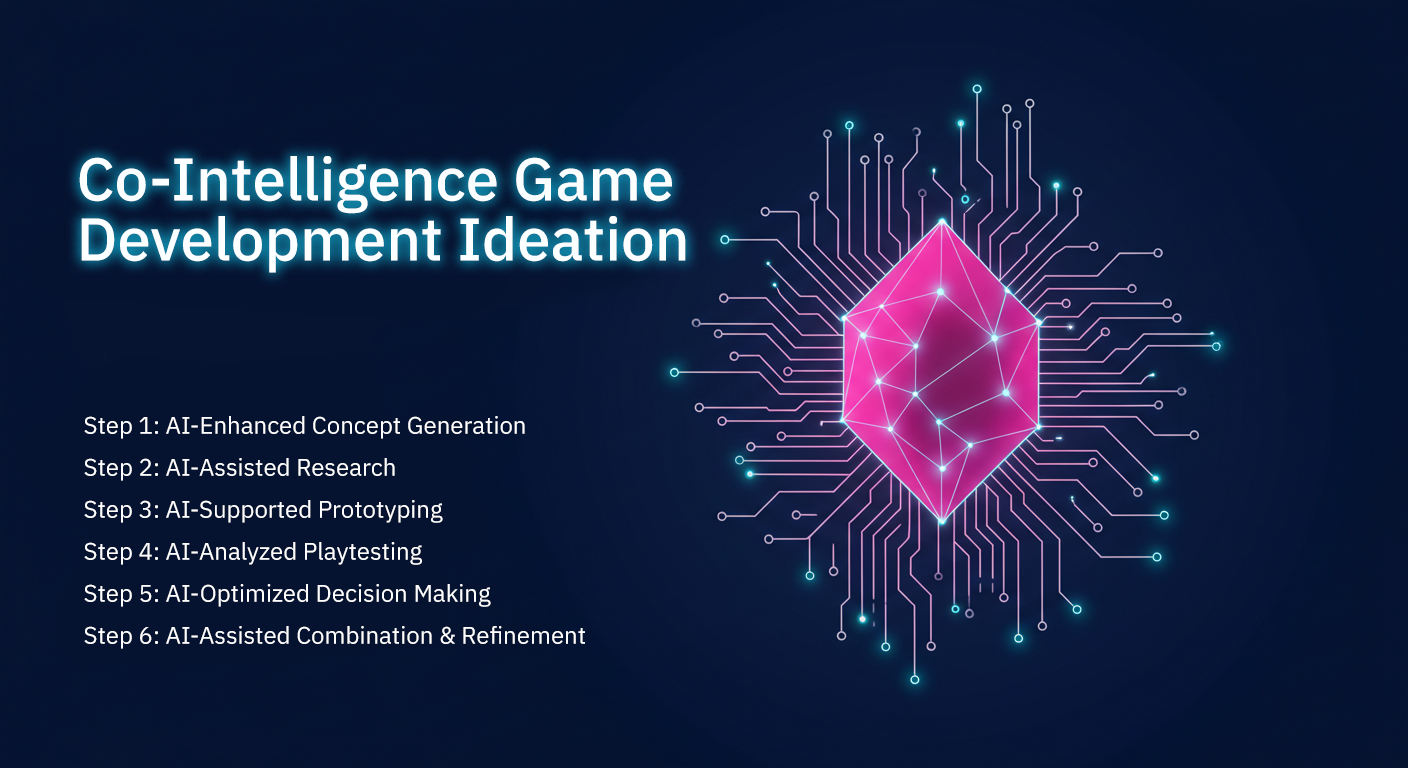Co-Intelligence: A New Framework for Indie Game Prototyping
Tired of Prototypes Dying? Let’s Talk About a Better Workflow. Hey fellow devs,
We’ve all been there. You have a brilliant idea at a game jam, or a concept that keeps you up at night. You start a new project, full of passion. But somewhere along the way, things get messy. The prototype stalls, communication breaks down, and that amazing idea ends up in the project graveyard. 묘
As an indie developer, I’ve lived this cycle, and I was convinced there had to be a better way to move from that first spark of an idea to a solid, playable prototype.
That’s why I created the CIGDI Framework.
What is the CIGDI Framework? CIGDI stands for Co-Intelligence Game Development Ideation.
Think of it as a playbook or a structured guide for the chaotic early stages of development. It’s designed specifically for solo developers and small teams to help you work smarter, not just harder.
The core idea is Co-Intelligence: treating modern AI not just as a tool, but as a creative partner or a junior assistant. The framework isn’t about letting AI build your game for you. It’s about using AI to streamline the tedious parts of development so you can focus on what’s important: making a great game.

The 6 Steps to a Better Prototype The framework is a simple, repeatable cycle. Here’s how it works:
Step 1: AI-Enhanced Concept Generation Instead of just brainstorming on a blank page, you use AI as a creative sparring partner. Feed it your core themes, mechanics, and inspirations, and let it generate dozens of unexpected ideas, character concepts, or story hooks to get your creativity flowing.
Step 2: AI-Assisted Research Building a GDD (Game Design Document) is crucial but time-consuming. Use AI to rapidly research competitors, summarize articles on game mechanics, find visual references, and even structure the initial draft of your GDD. It’s like having a research assistant who never sleeps.
Step 3: AI-Supported Prototyping This is where the magic happens. Use AI tools to generate placeholder assets—sprites, 3D models, textures, sound effects—in seconds. This allows you to build a functional, playable prototype incredibly fast, without getting bogged down in asset creation before you’ve even proven the core gameplay loop is fun.
Step 4: AI-Analyzed Playtesting You’ve got a prototype, now you need feedback. After a playtest session, you can feed the raw feedback (survey results, chat logs, notes) into an AI to have it summarize key takeaways, identify common complaints, and highlight the features players loved the most.
Step 5: AI-Optimized Decision Making Based on the playtest analysis, CIGDI helps you make smart decisions about what to do next. The framework uses a timeboxing approach, and AI can help you analyze the feedback to decide which features to work on for the next one-week or two-week “sprint.”
Step 6: AI-Assisted Combination & Refinement As you build multiple small prototypes testing different ideas, this step uses AI to help you see the bigger picture. It can help you document how different successful mechanics could be combined into a more cohesive, feature-rich game.
Why Use a Framework? The goal of CIGDI is simple: reduce friction and increase creative velocity.
Avoid Burnout: Automate the boring stuff.
Fail Faster: Quickly build and test ideas to find out what’s fun, before you invest hundreds of hours.
Stay Organized: Provide a clear structure for your process, which is a lifesaver for solo devs or small teams.
This project was recently validated during a research trip where it was presented to publishers like Gamirror, and even got an invitation from the Tencent Institute of Games to be used in their AI Creation Track. The industry sees the value in this structured approach, and I want to share it with the community here.
I’m starting up a research hub called Earth Online Lab to continue developing open-source tools and methods like this. If this sounds interesting to you, I’d love for you to follow along.
🛠️ Explore the Project on GitHub! This project is more than just a demo; it’s an open-source workshop designed to show the CIGDI framework in action. If you want to dive into the code, see how the project is structured, and follow our development process, everything is available on our GitHub repository.
What you’ll find there:
The Complete Unity Project: You can clone or download the repository and open it directly in Unity to see how everything works. Full CIGDI Documentation: Access our GameConceptDesign.md, TechnicalDesign.md, and NamingConventions.md to see how we plan our work before we code. Step-by-Step Task Lists: Check out NextSessionTasks.md to see the exact, granular tasks we’re working on for the current development sprint. A Live Development Log: Follow our progress, challenges, and solutions in our DevelopmentLog.md to get a real-world look at the development process. This repository is a learning tool. We encourage you to fork the project, experiment with the code, and see how the CIGDI principles can be applied to your own prototypes.
👉 CIGDI Prototyping Workshop: 2D Platformer in Unity
► Check out our introductory video on YouTube: Trip Video
Thanks for reading. Let me know your thoughts in the comments! What are your biggest struggles when starting a new project?
– Zeena
The CIGDI Framework
a workflow for junior devs using AI tools without getting completely wrecked
| Status | In development |
| Category | Other |
| Author | Zeenaz |
| Tags | Game Design, game-development, Open Source, productivity, Prototype, resource, workflow |

Leave a comment
Log in with itch.io to leave a comment.